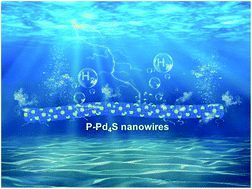Phosphorus-triggered modification of the electronic structure and surface properties of Pd4S nanowires for robust hydrogen evolution electrocatalysis†
Abstract
Rational design and fabrication of alternative, high-performance and robust non-Pt-based electrocatalysts is imperative for hydrogen production by means of the hydrogen evolution reaction (HER). In this work, we propose a synthetic strategy for the construction of P-doped Pd4S nanowires (P–Pd4S NWs) by treating the pre-synthesized Pd nanowires (Pd NWs) with triphenylphosphine sulphide under solvothermal conditions. After P-doping, the resultant P–Pd4S NWs were endowed with modified electronic structures, large electrochemically active surface areas, abundant active sites, and improved electron transport ability, which can trigger highly efficient electrocatalytic performance toward the HER. As a result, the as-obtained P–Pd4S NWs could achieve a HER activity of 10 mA cm−2 at a small overpotential of 47 mV, outperforming the Pd4S NWs and pristine Pd NWs. This study provides a new approach to optimize the performance of electrocatalysts by the rational combination of heteroatom doping and morphology/structure engineering.



 Please wait while we load your content...
Please wait while we load your content...